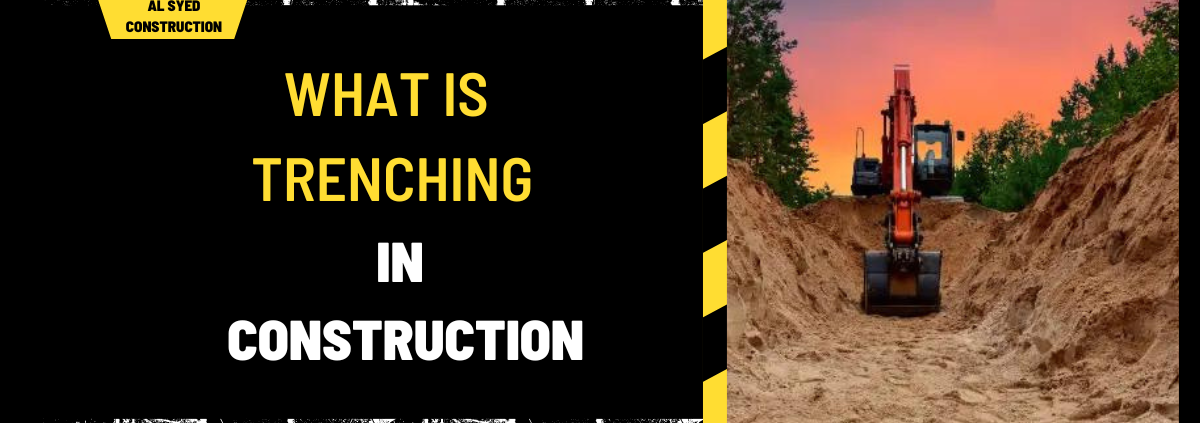What is Trenching in Construction? A Comprehensive Overview
Trenching is a critical process in construction that involves creating narrow, deep excavations in the ground for various purposes. These trenches serve as the foundation for utilities, drainage systems, and structural supports, making trenching an essential activity in both residential and commercial construction projects. This detailed guide explores the nuances of trenching, including its techniques, applications, and safety considerations.
Understanding Trenching in Construction
Trenching refers to the excavation of a trench, which is a long, narrow ditch-like hole, typically deeper than it is wide. This method is used to install or repair underground utilities such as water pipes, sewer lines, electrical cables, and telecommunications infrastructure. Trenching is also employed for foundations, retaining walls, and drainage systems.
Types of Trenches in Construction
Trenches can vary based on their depth, width, and purpose. Understanding the different types of trenches helps in selecting the appropriate method for each construction project.
- Utility Trenches
- Water and Sewer Lines: Trenches are dug to lay water pipes and sewer lines. Proper depth and alignment are crucial for the effective functioning of these utilities.
- Electrical and Communication Cables: Trenches for electrical and communication cables must be carefully planned to avoid interference with other utilities and ensure safety.
- Foundation Trenches
- Footings: Trenches are excavated to create footings for building foundations. These trenches must be level and correctly aligned to support the structure’s weight.
- Retaining Walls: For retaining walls, trenches provide a stable base to prevent soil erosion and ensure structural integrity.
- Drainage Trenches
- French Drains: Trenches are designed to install French drains, which help manage groundwater and prevent flooding.
- Swales: Shallow, wide trenches called swales are used to direct water flow and prevent erosion.
Trenching Techniques and Methods
Various techniques are employed in trenching, depending on the project’s requirements and site conditions. Each method has its advantages and considerations.
- Manual Trenching
- Hand Tools: In smaller projects or areas with limited access, manual trenching using shovels, spades, and picks is common. This method is labor-intensive and suitable for shallow trenches.
- Mechanical Trenching
- Excavators: For larger projects, mechanical trenching machines such as backhoes and mini-excavators are used. These machines can efficiently handle deeper and wider trenches.
- Trenchers: Specialized trenching equipment called trenchers can cut precise trenches in various soil conditions. They come in different types, including wheeled and tracked trenchers.
- Trench Shoring
- Shoring Systems: To prevent trench collapse, shoring systems such as trench boxes, hydraulic supports, and timbering are used. These systems provide stability and protect workers from potential cave-ins.
- Shielding: Trench shields are placed along the trench walls to protect workers and equipment. They are particularly useful in unstable soil conditions.
Safety Considerations in Trenching
Safety is paramount in trenching operations due to the inherent risks of cave-ins, falls, and equipment accidents. Implementing safety measures ensures a safe working environment and compliance with regulatory standards.
- Cave-In Prevention
- Soil Analysis: Before excavation, a soil analysis should be conducted to determine soil stability and select appropriate shoring systems.
- Safety Standards: Follow OSHA (Occupational Safety and Health Administration) guidelines for trench safety, including the use of protective systems and regular inspections.
- Trench Access and Egress
- Safe Entry and Exit: Provide safe access and egress points for workers, such as ladders or ramps. Ensure these points are secure and easily accessible.
- Hazard Identification
- Utility Marking: Identify and mark existing utilities before digging to prevent accidental damage and ensure worker safety.
- Weather Conditions: Monitor weather conditions to avoid excavation during adverse weather, which can increase the risk of trench collapse and flooding.
Applications of Trenching in Construction
Trenching plays a vital role in various construction applications, each with its unique requirements and benefits.
- Residential Construction
- Utility Installation: In residential projects, trenching is used for installing water, sewer, and electrical lines. Proper trenching ensures reliable utility services and prevents future issues.
- Foundation Work: For residential foundations, trenches are essential for creating stable footings and supports for walls and structures.
- Commercial Construction
- Infrastructure Development: In commercial projects, trenching is used for extensive utility networks, including high-voltage electrical lines and large-diameter sewer pipes.
- Parking Lots and Roadways: Trenches are excavated for drainage systems in parking lots and roadways to manage stormwater and prevent flooding.
- Industrial Construction
- Large-Scale Utilities: Industrial facilities require extensive trenching for utilities such as steam lines, fuel pipelines, and cooling systems.
- Foundation Support: Trenching is used to create deep foundations for heavy machinery and structures, ensuring stability and load-bearing capacity.
Best Practices for Effective Trenching
Adhering to best practices in trenching ensures efficient and safe operations while minimizing risks and delays.
- Planning and Design
- Detailed Plans: Develop detailed trenching plans that include dimensions, depths, and soil conditions. Incorporate safety measures and utility locations in the design.
- Permit Acquisition: Obtain necessary permits and approvals from local authorities before commencing trenching work.
- Equipment and Technology
- Proper Equipment: Use the appropriate trenching equipment for the project’s scale and soil conditions. Regularly maintain and inspect equipment to ensure optimal performance.
- Technology Integration: Utilize technology such as GPS and laser systems to improve trench accuracy and alignment.
- Training and Supervision
- Worker Training: Ensure that all workers are trained in trenching safety and procedures. Regularly update training to reflect new safety standards and technologies.
- Supervision: Provide adequate supervision to monitor trenching operations and enforce safety protocols.
Conclusion
Trenching is a fundamental aspect of construction that involves excavating narrow and deep ditches for various utilities, foundations, and drainage systems. Understanding the types of trenches, techniques, safety considerations, and best practices ensures successful and efficient trenching operations. By adhering to these guidelines and utilizing appropriate equipment, construction projects can achieve timely completion while maintaining high safety and quality standards.




